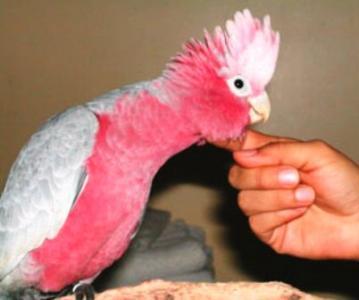
Galah, orRoseate cockatoo, orRed-breasted cockatoo, or«Rosies»(Cacatua roseicapilla, orEolophus roseicapilla, orEolophus roseicapillus,orKakatoe roseicapillus)
Phylum —chordata
Class — aves
Order — psittaciformes
Family — cacatuidae
Genus – cacatua
Appearance
Galahs are about 35 cm (14 in) long and weigh 270–350 g (10–12 oz). They have a pale silver to mid-grey back, a pale grey rump, a pink face and chest, and a light pink mobile crest. They have a bone-colored beak, and the bare skin of the eye rings is carunculated. They have grey legs. The sexes appear similar; however, generally adult birds differ in the color of the irises; the male has very dark brown (almost black) irises and the female has mid-brown or red irises.
Habitat
The Galah lives in most parts of Australia, including some offshore islands, and it has been introduced to Tasmania.
Behavior
A highly sociable bird, the Galah is often seen in huge flocks that number as many as 1,000 individuals. They tend to feed in either the morning or late afternoon. They often mix with other species of cockatoo. In hot weather, flocks spend much of their time sheltering among shrubs and trees. They are often seen in acrobatic postures, sometimes hanging upside down, holding on by one foot only, flapping their wings and giving a loud “scree!” At dusk, they perform further acrobatics before roosting. They fly swiftly through the treetops, twisting and turning as they swoop towards the ground, screeching as they go.
Diet
Galahs eat seeds, grains, fruits, nuts, berries, grasses, roots, leaf buds, green shoots, and insects and their larvae.
Reproduction
Galahs are monogamous birds and pairs mate for life. Males display to females by strutting towards them, with bobbing and waving of the head and raising of their crest, giving soft calls and also clicking their bill. The breeding season in the north is from February to July, and in the south from July to December. Galahs nest in tree hollows or in cavities in cliffs. Often many pairs nest close to each other. Females lay between 2 and 5 white eggs, and incubation lasts around 4 weeks, shared by the parents. The chicks are fed at the nest by their parents for 5 to 6 weeks. They then leave the nest to gather in a “crèche tree”, along with other young birds. For 2 to 3 more weeks they are still fed by their parents. Then the parents fly away to molt. The young are independent by between 6 and 8 weeks old. Young birds join large nomadic flocks with non-breeding birds until they are 2 to 3 years old. They are ready to breed when they are four years old.
In captivity
Living in captivity, Galahs can reach up to 80 years of age when a good-quality diet is strictly followed.
Your bird will want to spend a considerable amount of time with you and will be a reasonably high-maintenance pet. If you are short on time for interaction, this bird might be happier housed with another Galah.
These parrots need sound sleep in a dark, quiet place that mimics the safety of the roosting areas that they prefer when living in the wild. Covering the bird's cage at night usually reassures them.
This bird is not a large parrot but still requires plenty of space. At the very least, it needs a 4-foot-square cage.
Galahs are active birds, and they need plenty of exercise to maintain their physical health. Pan on giving this bird at least three to four hours of active time outside of the cage each day.
Cockatoos have strong beaks and jaws, so it's essential to provide plenty of safe toys made of wood or leather that allows them to exercise their jaw muscles and satisfy the natural chewing instinct. Toys are an important part of enrichment for these birds. Change out the toys regularly to keep the birds interested and to encourage independent play.
When kept as pets, feed Galahs a balanced diet. High-quality formulated pellets have been developed to meet all your bird's nutritional needs. At least 50 percent of your bird's diet should be in pellet form. The other half of their diet should be fruits and vegetables. Start by feeding 1/4 cup of pellets and 1/4 cup of fresh salad daily. Incrementally increase as needed.
Great choices for fresh vegetables include leafy greens such as Swiss chard, kale, Chinese cabbage, and romaine; root vegetables; peppers; zucchini; green beans; and sprouts. They love most fruits and berries. Give walnuts, almonds, and pecans sparingly as training treats. Fresh water should be available at all times.
 Russian
Russian
 English
English























